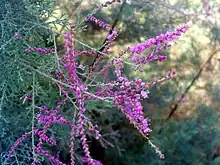Tamarix parviflora
Tamarix parviflora is a species of tamarisk known by the common name smallflower tamarisk.[2]
| Smallflower tamarisk | |
|---|---|
 | |
| Scientific classification | |
| Kingdom: | Plantae |
| Clade: | Tracheophytes |
| Clade: | Angiosperms |
| Clade: | Eudicots |
| Order: | Caryophyllales |
| Family: | Tamaricaceae |
| Genus: | Tamarix |
| Species: | T. parviflora |
| Binomial name | |
| Tamarix parviflora | |
| Synonyms | |
|
Tamarix cretica | |
It is native to south-eastern Europe (Albania, East Aegean Islands, Greece, Crete and the former Yugoslavia) and to Turkey.[1] It has been introduced elsewhere, in places such as; Algeria, Austria, Cape Provinces, Corsica, Italy, Libya, Mexico, Pakistan, Sicily, Spain, West Himalayas and western North America (Arizona, California, Colorado, Illinois, Kansas, Kentucky, Mississippi, Nevada, New Mexico, New York, North Carolina, Oklahoma, Oregon and Texas),[3] where it is an invasive introduced species.
It easily inhabits moist habitat, especially in saline soils. It is a shrub or tree growing up to about 5 meters tall. The branching twigs are covered in tiny linear leaves no more than 2 or 3 millimetres long. The inflorescence is a dense spike with flowers 1 to 4 centimeters long. Each tiny flower has four pink petals.
It was first published and described by Augustin Pyramus de Candolle in Prodr. vol.3 on page 97 in 1828.[3]
References
- Akhani, H. (2020). "Tamarix parviflora". IUCN Red List of Threatened Species. 2020: e.T19179463A175309447. Retrieved 2 October 2023.
- USDA, NRCS (n.d.). "Tamarix parviflora". The PLANTS Database (plants.usda.gov). Greensboro, North Carolina: National Plant Data Team. Retrieved 8 December 2015.
- "Tamarix parviflora DC. | Plants of the World Online | Kew Science". Plants of the World Online. Retrieved 22 May 2022.
